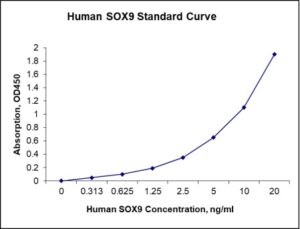Nori Human SOX9 ELISA Kit
$461.00 – $832.00
This ELISA kit is for quantification of SOX9 in human. This is a quick ELISA assay that reduces time to 50% compared to the conventional method, and the entire assay only takes 3 hours. This assay employs the quantitative sandwich enzyme immunoassay technique and uses biotin-streptavidin chemistry to improve the performance of the assays. An antibody specific for SOX9 has been pre-coated onto a microplate. Standards and samples are pipetted into the wells and any SOX9 present is bound by the immobilized antibody. After washing away any unbound substances, a detection antibody specific for SOX9 is added to the wells. Following wash to remove any unbound antibody reagent, a detection reagent is added. After intensive wash a substrate solution is added to the wells and color develops in proportion to the amount of SOX9 bound in the initial step. The color development is stopped, and the intensity of the color is measured.
Alternative names for SOX9: transcription factor SOX9, SOX-9
This product is for laboratory research use only not for diagnostic and therapeutic purposes or any other purposes.
- Description
- How Elisa Works
- Product Citations
- Reviews (0)
Description
Nori Human SOX9 ELISA Kit Summary
Alternative names for SOX9: Transcription factor SOX-9, SOX-9
| Assay Type | Solid Phase Sandwich ELISA |
| Format | 96-well Microplate or 96-Well Strip Microplate |
| Method of Detection | Colorimetric |
| Number of Targets Detected | 1 |
| Target Antigen Accession Number | P48436 |
| Assay Length | 3 hours |
| Quantitative/Semiquantitative | Quantitative |
| Sample Type | Plasma, Serum, Cell Culture, Urine, Cell/Tissue Lysates, Synovial Fluid, BAL, |
| Recommended Sample Dilution (Plasma/Serum) | No dilution for sample <ULOQ; sufficient dilution for samples >ULOQ |
| Sensitivity | 60 pg/mL |
| Detection Range | 0.313-20 ng/mL |
| Specificity | Human SOX9 |
| Cross-Reactivity | < 0.5% cross-reactivity observed with available related molecules, < 50% cross-species reactivity observed with species tested. |
| Interference | No significant interference observed with available related molecules |
| Storage/Stability | 4 ºC for up to 6 months |
| Usage | For Laboratory Research Use Only. Not for diagnostic or therapeutic use. |
| Additional Notes | The kit allows for use in multiple experiments. |
Standard Curve
Kit Components
1. Pre-coated 96-well Microplate
2. Biotinylated Detection Antibody
3. Streptavidin-HRP Conjugate
4. Lyophilized Standards
5. TMB One-Step Substrate
6. Stop Solution
7. 20 x PBS
8. Assay Buffer
Other Materials Required but not Provided:
1. Microplate Reader capable of measuring absorption at 450 nm
2. Log-log graph paper or computer and software for ELISA data analysis
3. Precision pipettes (1-1000 µl)
4. Multi-channel pipettes (300 µl)
5. Distilled or deionized water
Protocol Outline
1. Prepare all reagents, samples and standards as instructed in the datasheet.
2. Add 100 µl of Standard or samples to each well and incubate 1 h at RT.
3. Add 100 µl of Working Detection Antibody to each well and incubate 1 h at RT.
4. Add 100 µl of Working Streptavidin-HRP to each well and incubate 20 min at RT.
5. Add 100 µl of Substrate to each well and incubate 5-30 min at RT.
6. Add 50 µl of Stop Solution to each well and read at 450 nm immediately.
Background:
Transcription factor SOX-9 is a protein that is encoded by the SOX9 gene. SOX-9 recognizes the sequence CCTTGAG along with other members of the HMG-box class DNA-binding proteins. It is expressed by proliferating but not hypertrophic chondrocytes that is essential for differentiation of precursor cells into chondrocytes and, with steroidogenic factor 1. SOX9 regulates transcription of the anti-Müllerian hormone (AMH) gene. SOX-9 plays a pivotal role in male sexual development; by working with Sf1, SOX-9 can produce AMH in Sertoli cells to inhibit the creation of a female reproductive system.[1] Activation of FGF9 by SOX-9 starts vital processes in male development, such as the creation of testis cords and the multiplication of Sertoli cells.[2] The association of SOX-9 and Dax1 actually creates Sertoli cells, another vital process in male development.[3] In the brain development, its murine ortholog Sox-9 induces the expression of Wwp1, Wwp2, and miR-140 to regulate cortical plate entry of newly born nerve cells, and regulate axon branching and axon formation in cortical neurons.[4] SOX-9 is a target of the Notch signaling pathway, as well as the Hedgehog pathway,[5] and plays a role in the regulation of neural stem cell fate. In vivo and in vitro studies show that SOX-9 negatively regulates neurogenesis and positively regulates gliogenesis and stem cell survival.[6]
The Sox9 protein has been implicated in both initiation and progression of multiple solid tumors. Its role as a master regulator of morphogenesis during human development makes it an ideal candidate for perturbation in malignant tissues. Specifically, Sox9 appears to induce invasiveness and therapy-resistance in prostate,[7] colorectal,[8] breast[9] and other cancers, and therefore promotes lethal metastasis. Many of these oncogenic effects of Sox9 appear dose dependent.
References
- De Santa Barbara P, et al. (1998). Molecular and Cellular Biology. 18 (11): 6653–65.
- Kim Y, et al. (2006). PLOS Biology. 4 (6): e187. doi:10.1371/journal.pbio.0040187.
- Bouma GJ, et al. (2005). Development. 132 (13): 3045–54. doi:10.1242/dev.01890.
- Ambrozkiewicz MC, et al. (2018). Neuron. 100 (5): 1097–1115.e15.
- Place E, et al. (2022) Front. Neurosci. 16:855288. doi: 10.3389/fnins.2022.855288
- Vogel, Julia K., et al. (2014). Genes & Diseases. 1 (2): 149–161.
- Nouri M, et al. (2020). Clinical Cancer Research. 26 (7): 1678–1689.
- Prévostel C, Blache P (2017). European Journal of Cancer. 86: 150–157.
- Grimm D, et al. (2019). Seminars in Cancer Biology. 67 (Pt 1): 122–153.
Product Citations
Be the first to review “Nori Human SOX9 ELISA Kit”
You must be logged in to post a review.





























Reviews
There are no reviews yet.